根属植物间亲缘关系的同工酶证据
IF 1.5
4区 生物学
Q4 PLANT SCIENCES
引用次数: 1
摘要
摘要根茎属是蕨科两个物种最多的属之一,包括14至16个已命名的分类群,可能还有更多的分类群有待描述。我们先前的研究证实,伪刺毛鼠是异源二倍体,其单倍体祖先是细毛鼠和magnifolium。在这项工作的过程中,我们又取样了五个物种作为可能的祖先。利用淀粉凝胶电泳的同工酶,我们对所有8个物种进行了筛选,比较了种内遗传变异水平、种间遗传距离和遗传群体结构。变异水平一般低于斜草属,但与钩草属相似。基于遗传资料的种间关系与Koponen(1973)关于根属植物的“假设系统发育”基本一致,但也存在明显的矛盾。例如,阿巴拉契亚蒿(r.a appalachianum)与其他三个被归入根茎节的种有高度的差异,而光毛蒿(r.a glabrescens)似乎不属于根茎节。然而,遗传距离数据确实支持Koponen & Sun(2016)将R.叶绿素和R. punctatum区分开来的观点。本文章由计算机程序翻译,如有差异,请以英文原文为准。
Isozyme evidence regarding relationships within Rhizomnium (Mniaceae)
Abstract. One of the two most speciose genera in the Mniaceae, Rhizomnium includes 14 to 16 named taxa with the likelihood that more remain to be described. Our previous research established that R. pseudopunctatum is an allodiploid whose haploid progenitors are R. gracile and R. magnifolium. In the course of that work, we sampled five additional species as possible progenitors. Using isozymes from starch-gel electrophoresis, we screened all eight species to compare levels of genetic variation within species, genetic distances between species, and genetic population structure. Levels of variation are generally lower than for species of Plagiomnium but are similar to those for species of Cinclidium. Relationships of species based on genetic data are mostly congruent with Koponen's (1973) “assumed phylogeny” of Rhizomnium, but there are also some clear conflicts. For example, R. appalachianum is highly divergent from the other three species placed in sect. Macromnium, and R. glabrescens does not seem to fit in sect. Rhizomnium. Genetic distance data, however, do support Koponen & Sun's (2016) recognition of R. chlorophyllosum as a separate species from R. punctatum.
求助全文
通过发布文献求助,成功后即可免费获取论文全文。
去求助
来源期刊

Bryologist
生物-植物科学
CiteScore
2.40
自引率
11.10%
发文量
40
审稿时长
>12 weeks
期刊介绍:
The Bryologist is an international journal devoted to all aspects of bryology and lichenology, and we welcome reviews, research papers and short communications from all members of American Bryological and Lichenological Society (ABLS). We also publish lists of current literature, book reviews and news items about members and event. All back issues of the journal are maintained electronically. The first issue of The Bryologist was published in 1898, with the formation of the Society.
Author instructions are available from the journal website and the manuscript submission site, each of which is listed at the ABLS.org website.
All submissions to the journal are subject to at least two peer reviews, and both the reviews and the identities of reviewers are treated confidentially. Reviewers are asked to acknowledge possible conflicts of interest and to provide strictly objective assessments of the suitability and scholarly merit of the submissions under review.
 求助内容:
求助内容: 应助结果提醒方式:
应助结果提醒方式:


